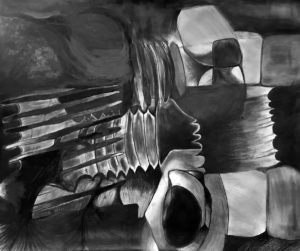
The Man in the Wagon
By Delanie Donovan '19
ENGL-343: Travel Writing
This was an open essay assignment in ENG 343, “Travel Writing.” In “the Man in the Wagon,” Delanie bikes across one of Ireland’s Aran Islands. It’s a lyric meditation on books, landscape, prayer, and a traveler’s ability to see even the most mundane things with new eyes.
-Keith Ratzlaff
The Irish Sea breeze blew my hair, tickling my face and ears as it danced in the wind and I swore I could taste the sea salt on my lips. I blame my favorite childhood novel, Anne of Green Gables by L.M. Montgomery for making me fall in love with the outdoors. Although her novels are based on the eastern coast of Canada, Anne of Green Gables described the world I imagined Ireland to be. To my left stood a cottage with smoke curling out of the chimney. A single dirt track led up to the front of the house and a stone fence separated the yard from the road I was on.

Tim Brunnert, paper
At the mouth of the Galway Bay, the western most of Ireland’s Aran Islands, sits Inishmore. A mostly Gaelic speaking community, the Aran Islands are popular for their sweaters, although I wasn’t incredibly impressed with the nearly 200 euro price tags. I was more impressed with the quaint village and prehistoric clifftop fort I was biking towards. The clifftop fort, named Dún Aonghasa was only a thirty-minute bike ride from the pier across the island, but I was in no rush to get there. I figured, if the fort had stood for this many centuries, it could stand for another hour while I made my way across the island.
My feet pumped up and down on the pedals, but my legs felt no burn as my bike glided on the road. It wasn’t quite cobblestone but it wasn’t pavement either. Tiny rocks kicked up and kissed my calves. A man riding in a wagon behind a horse tipped his hat as our paths crossed. I was sure he was used to seeing tourists in his village. I wondered if our marvel for the beauty of his home made him more appreciative of it. Instead of the “same old view” day in and day out, I hoped he woke each morning and saw something through the eyes of a newcomer.
My wandering eyes couldn’t decide if they wanted to gaze at the sea or country side, so they darted back and forth. I pondered the man in the wagon. What did he do, every day, on this small island? It was completely surrounded by water and had taken me nearly an hour to get here by ferry. I hadn’t heard him talk but knowing that the majority of the islands’ population spoke Gaelic, I wondered if he would have understood me if I tried to express my appreciation for his home.
But more than that, I wondered what he saw. What did he see when he woke up every morning, with the sound of the waves crashing against the rocks? Was he seeing everything like me, in this moment, or was he taking in the scenery with a seasoned eye? What I saw as a perfectly quaint cottage could really be in desperate need of repair.
There is comfort in the familiar and awe in the new. Both are good, none above the other, and each has its place. Since stepping foot in Ireland, I had been completely awestruck. I felt as if all of my favorite childhood authors, L.M. Montgomery, Jane Austen, C.S. Lewis and Laura Ingalls Wilder had captured my wonder of new, glorious, and simple things and put it all into one place. Every girlhood dream to have ever crossed my mind, no matter how silly, felt as if they could come true. This was the land of leprechauns and fairies, of wonderful accents and kind eyes.
On the other hand, I loved the comfort and familiarity of home, as I’m sure this man did as well. Jane Austen’s character Emma understood perfectly well that there is nothing like staying at home for real comfort. He looked quite content up on his wagon, tipping his suede hat with his blue eyes twinkling. Anne of Green Gables always said that traveling marks an epoch in life, but the best part of all is coming home. Coming home to a quaint cottage, sheep grazing in the yard and the sunset over the sea is likely all this man had known. I bet he fell asleep every night with the sunset stuck in his mind and that he rose every morning in anticipation for the routine he had built for himself after so many years on the island.
“Dear old world,” I muttered, pulling from my collection of favorite L.M. Montgomery quotes, “you are very lovely and I am glad to be alive in you.” I angled the front of my bike to prepare for a bend in the road. A sheep grazing to my left lazily nibbled grass as I peddled passed. If reincarnation is real and I had lived a different life, I hoped it involved this island with grazing sheep and the pebbly shores of the Irish Sea.
The sun broke through the clouds and I pulled off to the side to remove a few layers of clothing. I was still getting used to the United Kingdom and its seemingly never-ending rainy season. I stuffed my raincoat into my backpack and took a swig of water, relishing the soft sunshine that rested gently on the surface of my sweatshirt. The wind tugged at my hair; I had gotten it cut right before leaving America and it was in its beginning stages of growing back out. My heart pounded, not because of the physical toll of biking but because I was truly convinced I had never seen anything more beautiful.
With the countryside at my back, the sea swallowed me. I had never felt so small, so insignificant, and yet so completely whole and understood at the same time. I imagined the man pulling his wagon off to the side to breathe in the scenery. I hoped this was a view he never tired of – how could you? Waves crashed against the beach, its pebbles dancing in and out with the tide. They clicked together in a sing-song way. Standing on the rocky shore, I was reminded of C.S. Lewis describing God as flowing into us from the blue of the sky. I had never understood what he meant until that moment.
I wish I had seen what the man had in the back of his wagon. The romantic part of me, the part who was obsessed with Laura Ingalls Wilder and Little House on the Prairie, imagined a wagon full of fabric parcels to turn into beautiful dresses, but I knew that wasn’t logical. Irish people wore normal clothes, not dresses from the 1800’s. Perhaps it was timber or stones for a fence. I couldn’t imagine it being food for sheep, since it appeared to me that all they needed was a pasture of grass and Lord knew Ireland had plenty of that.
I knew I was ending the trail when up ahead I saw several buildings with bike racks and signs for sandwiches. I highly doubted the man in the wagon ate here; it had the look of a tourist shop as opposed to a local deli. Where would he go for lunch today?

Ryan Berg, “Escape,” graphite
Icon image
As excited as I was to get to the fort, I wasn’t quite ready for the bike ride to end. From the corner of my eye, I saw a black swish, and it caused me to swerve on the road. The trail had led me to an open field of cows. This made me pause – there were cows in Ireland? They moseyed their way around, noses shoved to the ground. Their tails whipped back and forth and they kicked their hooves against the dirt. Their dung stung my nose the same way it does when at home, and that’s when I realized that cows are cows no matter what country you find yourself in. I got as close to the stone fence separating us as I dared and stared. A cow came up to me, sloshing his food around in his mouth with drool sliding out of his lip.
Where could the man on the wagon have come from? I had ridden the length of the island and had no indication of where he had come from or where he was going. Maybe he was unloading his wagon onto a ferry. That’s what Laura Ingalls Wilder’s father did, only he loaded it onto trains.
Upon parking my bike, stone steps were carved into the earth that led me through a countryside where the wind whistled freely and smelled of sea. I brushed my hair out of my eyes again, reveling in the wide-open meadow surrounding the path. Around me I heard a variety of accents but recognized none as what I imagined the man on the wagon to have. Surely, he had been up to this cliff before.
All my life, I had heard people say they preferred to pray in nature rather than in church. I had never understood that, until this moment. My arms erupted in what I’ve always called Holy Spirit Goosebumps. I thought of Laura Ingalls Wilder, how she believed that old fashioned things like air and sunshine are hard to beat. I thought of L.M. Montgomery’s description of Anne, who said she would pray by going into a great big field all alone or into the deep, deep woods and look up into the lovely blue sky and just feel a prayer. My footsteps sounded steady against the rocks. I looked up to the sky, remembering C.S. Lewis saying that proud men never see God because they were always looking down.
God was in his heaven, as Anne would say, I was sure of it. God was probably really close friends with the man in the wagon. I bet they went on walks together along the coast every night. I wondered what God and the man talked about, or if they even talked at all. After their walk, the man probably went home to his cottage, stopping momentarily at the fields with his cattle and sheep as the sun slowly inched its way under the horizon. Once home, he would unload his wagon full of bags and retire to his cottage where he would kiss his wife goodnight before they fell asleep.